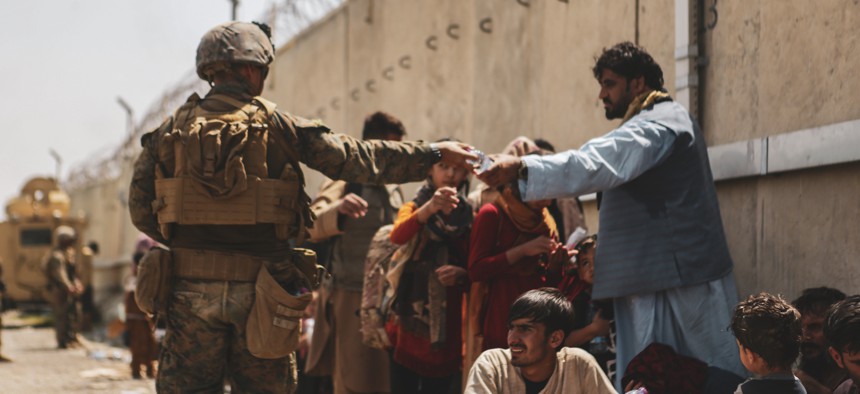
A Marine with the 24th Marine Expeditionary unit (MEU) passes out water to evacuees during an evacuation at Hamid Karzai International Airport, Kabul, Afghanistan, Aug. 22. Sgt. Isaiah Campbell / U.S. Marine Corps
Not For the First Time, COVID Takes Back Seat to a More Pressing Crisis
The evacuation of refugees from Afghanistan depends on cramming people into closed spaces—during a global pandemic.
The United States has evacuated tens of thousands of people from Afghanistan in recent weeks, flying hundreds at a time in C-17s to makeshift refugee camps with questionable sanitation standards. It’s a situation almost tailor-made to spread COVID-19.
Each stage of the evacuation process brings new opportunities for contagion. Images at Hamid Karzai International Airport show few masks and even less instances of social distancing. Viral photos of packed evacuation flights have evacuees sitting shoulder-to-shoulder. And the cots in makeshift refugee camps are roughly two feet apart.
Asked about COVID-19 prevention measures, Pentagon spokesperson John Kirby has explained that there are several screening points in the process, but mainly for those who are asymptomatic or “feeble” and only at some locations.
And some of those locations are less conducive to COVID-19 prevention than others. The refugee set-up at Al Udeid Air Base in Qatar, for example, has been described as “squalid.”
“We are aware of and as concerned as anyone about what have been some terrible sanitation conditions at Qatar that were facilitated by the sheer numbers and the speed with which those numbers got there,” Kirby said. “Nobody here wants anyone to be less than safe, secure, comfortable, and well-cared for as they go through this process.”
Kirby said the conditions in Qatar are “improving” but not “perfect.”
Once they reach the United States, Kirby said that all evacuees from Afghanistan are being tested. This has not assuaged concerns from the families at the military installations receiving refugees.
“They have every right to be [concerned],” Kirby said. “We’re in the midst of a pandemic and conducting one of the largest airlift operations in recent American history. It’s no small feat in the best of circumstances, and this one obviously is not the best of circumstances.”
“We’re doing the best we can to make sure we’ve got enough visibility on everyone’s health. But again, really, the focus is on getting the numbers out,” he added.
In addition to the tens of thousands of evacuees, there are thousands of U.S. service members also facing exposure.
“I don’t know what positive results may have come in for soldiers working at the airfield, but obviously their health and safety remains a top concern for all of us,” Kirby said when asked about service member COVID-19 rates on Monday.
With the full FDA approval of the Pfizer BioNTech COVID-19 vaccine, service members will now be required to get vaccinated against the coronavirus. But that approval occurred only after the situation in Kabul necessitated rapid troop deployments.
As the COVID-19 pandemic has dragged on for well over a year, this is not the first time it has been eclipsed as the most pressing crisis and Centers for Disease Prevention and Control recommendations have largely gone out the window.
In June 2020, following the killing of George Floyd, protestors flooded city streets across the country. Just months after the pandemic first began, there was concern that protests would result in a spike in COVID-19 cases. No such spike was reported, which the New York Times attributed to mask-wearing and that the protests were held outdoors.
Six months later, when tens of thousands of Guard troops were deployed to the nation’s capital after the January 6 insurrection, lawmakers worried that COVID-19 would spread freely.. About 150 Guard troops who deployed to the Capitol tested positive for the illness out of the 25,000 or so there: around a 0.6% COVID-positive rate.
Neither of these recent examples resulted in significant increases in cases of COVID-19, suggesting the United States can handle a crisis on top of a pandemic. But will Afghanistan be different?
Just last month, NPR reported that almost half of all Afghans being tested for COVID-19 by the United Nations produced positive tests. The current positivity rate in the U.S. is 9.7% while Afghanistan’s is 42%. The United Nations suggested that the Delta variant may be responsible for the spike in Afghanistan’s COVID-19 rate—the same way the variant may be contributing to the recent spike in military COVID-19 fatalities.
“Obviously, we’re deeply concerned by the trends and the numbers,” Kirby said in response to the recently reported fatalities. “And our thoughts and prayers go out to the loved ones and family members of those who have lost their lives to this pandemic, not just here in the department, but across the country as the delta surge continues to claim more victims.”
Afghanistan evacuation efforts are only expected to intensify in the days leading up to the Aug. 31 deadline, with tens of thousands more refugees to move across the globe. Any significant COVID-19 effects will reveal themselves in the months to follow.




